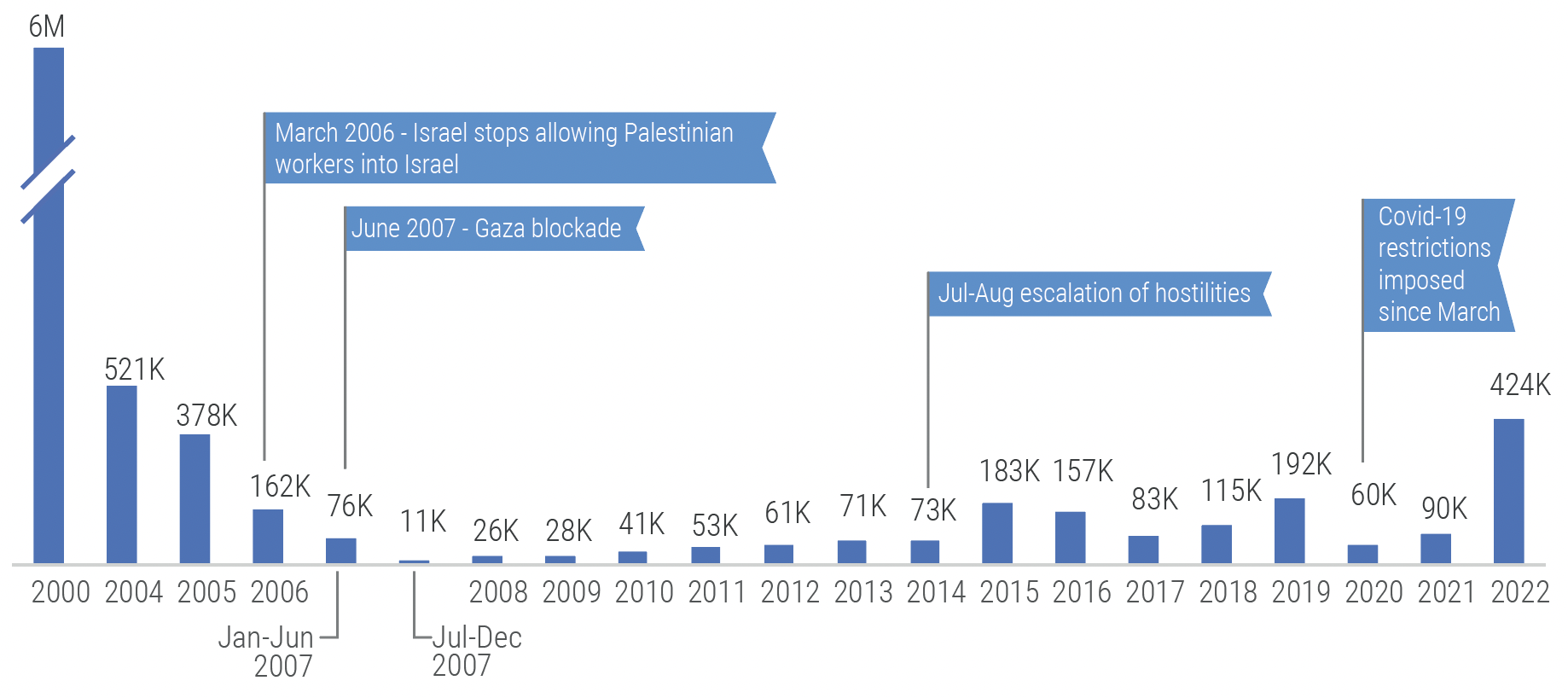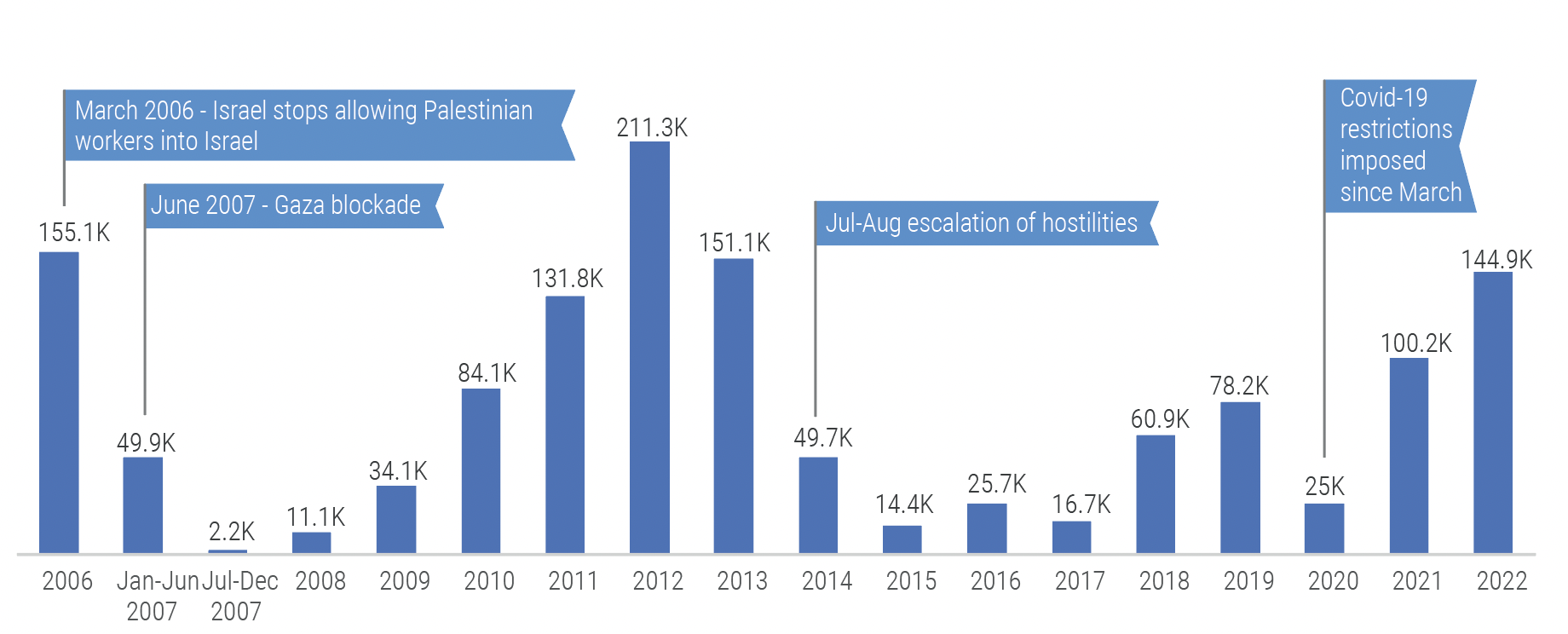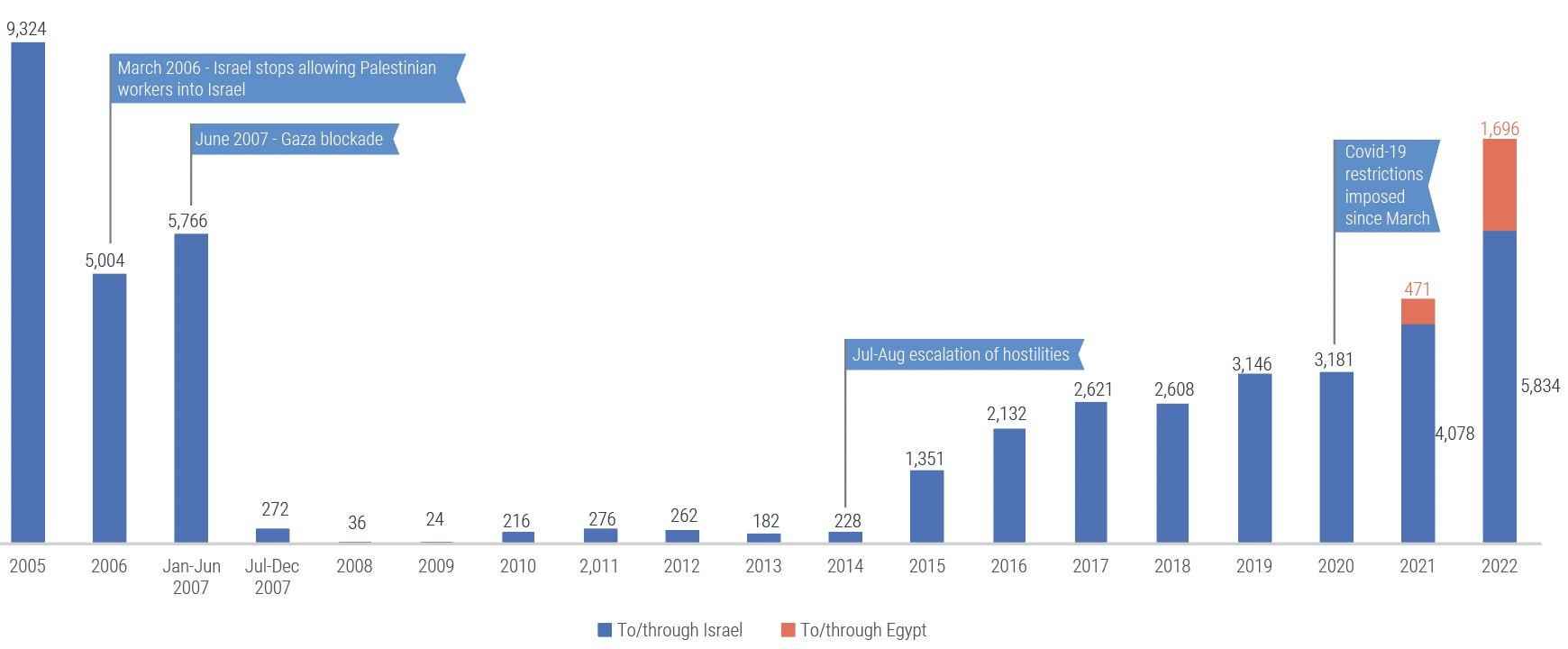Movement in and out of Gaza in 2022
Over 60 per cent of Palestinians in the Gaza Strip need humanitarian assistance. Restrictions on their movement, as well as on the exit and entry of commodities, are among the main reasons for this extremely high rate, alongside recurrent escalations of hostilities, the intra-Palestinian political divide, and other factors. The land perimeter of Gaza is fenced off, with limited movement being channelled through three operational crossings: two Israelis and one Egyptian. Restrictions intensified with the imposition of a blockade by the Israeli authorities in mid-2007. Exits and entries by air or sea are banned.
Highlights
- In 2022, more people were let out of Gaza; however, their movement remained the exception rather than the rule, with the vast majority of residents, over 2 million people, virtually ‘locked in.’ The number of exit permits for workers and traders issued by Israeli authorities increased from just over 10,000 in January 2022 to more than 18,000 in November 2022. This has allowed more exists of people compared with any time since the early 2000s. At the same time, the Egyptian authorities allowed more exits than any time since 2014.
- Less authorized goods were brought in through Israel and more were imported through Egypt. Goods exiting through either border increased and, for the first time, exceeded the pre-blockade annual figures. However, the Israeli authorities continued to only allow certain commodities out, mostly agriculture products, and restricted the entry of hundreds of items they classified as having dual civil-military use.
- While Increased movement is a positive trend, it has not yet been translated into meaningful improvements in humanitarian indicators; a full lifting of the blockade is required, among other solutions to the root causes. As of July 2022, the food insecurity rate in Gaza was 65 per cent, up from 62.2 per cent in June 2021, and the poverty rate stood at 65 per cent, up from 59 per cent in 2021.
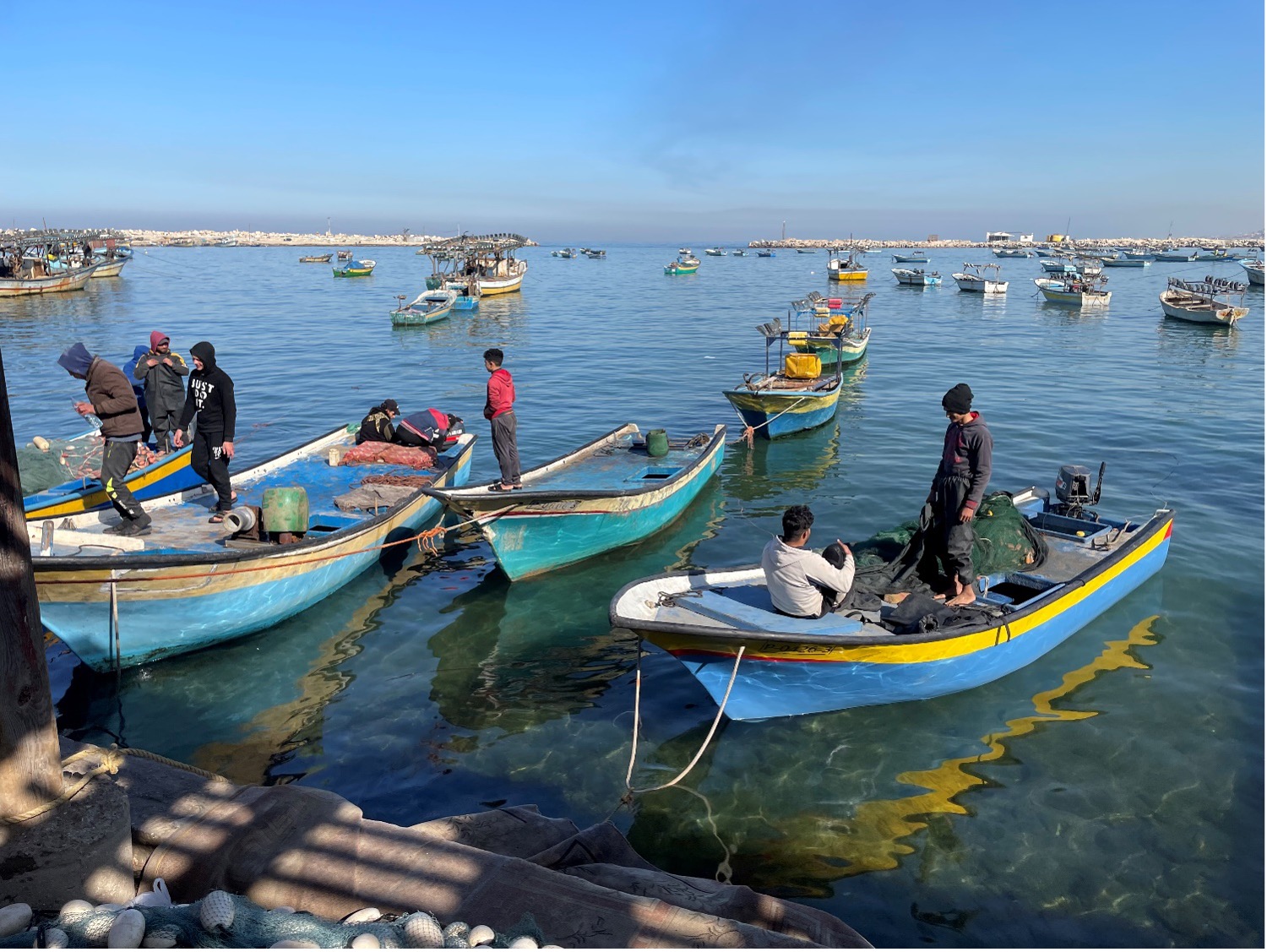
The Gaza Strip is the only part of the occupied Palestinian territory (OPT) with access to the Mediterranean Sea. However, in 2022, sailing restrictions remained at 6-15 nautical miles offshore and the transport of fish to other parts of the OPT was intermittently banned by the Israeli authorities. Those restrictions continue to undermine food security. Photo by OCHA
The movement of people to Israel and the West Bank
- In 2022, the Israeli authorities allowed more exits of people. The 424,417 exits recorded during the year are 93 per cent less than in 2000, before the imposition of a restriction whereby only those belonging to certain categories may apply for exit permits. However, it is five times higher than the number of exits recorded in 2021, and the highest figure since 2004. In most cases, travelers exited multiple times.
- Some 83 per cent of the exits in 2022 were by day labourers, and about 7 per cent were by patients and their companions. Exiting labourers typically work in Israel, and referral patients often rely on services that are only available in the West Bank, especially in East Jerusalem, which is only accessible to them if they cross through Israel. In 2022, only two in every three applications submitted for referral patients to exit were approved by the time of their scheduled appointment.
- Most Palestinians do not fall under the recognized categories and are thus not eligible for a permit even if their movement is to the West Bank, within the occupied Palestinian territory, and even when the Israeli authorities have not raised security concerns with regards to them. The Israeli-controlled Erez crossing generally operates during the daytime, from Sunday to Thursday, and on Fridays for urgent cases and foreign nationals only.
The movement of people to Egypt
- In 2022, the Egyptian authorities allowed more exits of people through their border. The 144,899 exits recorded during the year are 44 per cent more than in 2021, representing the highest figure since 2014.
- The crossing of 4,905 people to Egypt was denied. This is 23 per cent lower than the figure for 2021. Crossing is often denied for age-related requirements, which are more demanding for people between 18 and 40 years old. However, the grounds for denial are often not provided.
- Palestinians wishing to leave Gaza via Egypt must register with the local Palestinian authorities two to four weeks in advance or apply to the Egyptian authorities through a private company. The procedures and decisions by both authorities lack transparency and involve expenses. The journey through the Sinai desert is often lengthy and includes multiple stops for checks by Egyptian forces. Rafah crossing generally operates during the daytime, from Sunday to Thursday only.
Incoming goods
General goods (excluding fuel and gas)
- In 2022, fewer goods entered from Israel into Gaza, for a total of 74,096 truckloads. While commodities entering from Israel more than doubled compared with the average for the first seven years of the blockade, in 2022 they were 26 per cent below the annual average of 100,477 truckloads between 2015 and 2021.
- The Israeli-controlled Kerem Shalom crossing operated on 237 days. Since the imposition of the blockade in 2007, the Israeli authorities have restricted the entry of goods they consider having a dual civil-military use, some of which may be allowed in following a lengthy process.
- The Egyptian authorities more than doubled the volume of goods allowed into Gaza through their border, letting 32,353 truckloads in, up from 14,974 in 2021. This is more than five times the annual average of 5,918 truckloads recorded between 2015 and 2021 and the largest figure since monitoring began.
- Imports from Egypt were allowed in on 150 days. Allowed since 2018, such goods go in via the Egyptian-controlled Rafah crossing and then through the adjacent Salah Ad Din Gate, controlled by the local authorities.
- Overall, 106,449 truckloads of imported goods were allowed to enter Gaza through any of the borders. This is about 12 per cent above the 95,335 truckloads that entered in 2021 and slightly higher the annual average of 106,369 truckloads that entered between 2015 and 2021.
- Up to 50 per cent of the supplies were of construction materials, including aggregates, steel bars and cement, and 25 per cent of the deliveries contained food. Another 4 per cent (3,936 truckloads) carried humanitarian aid facilitated by international organizations, including food and medical supplies.
Incoming goods to Gaza (truckloads)
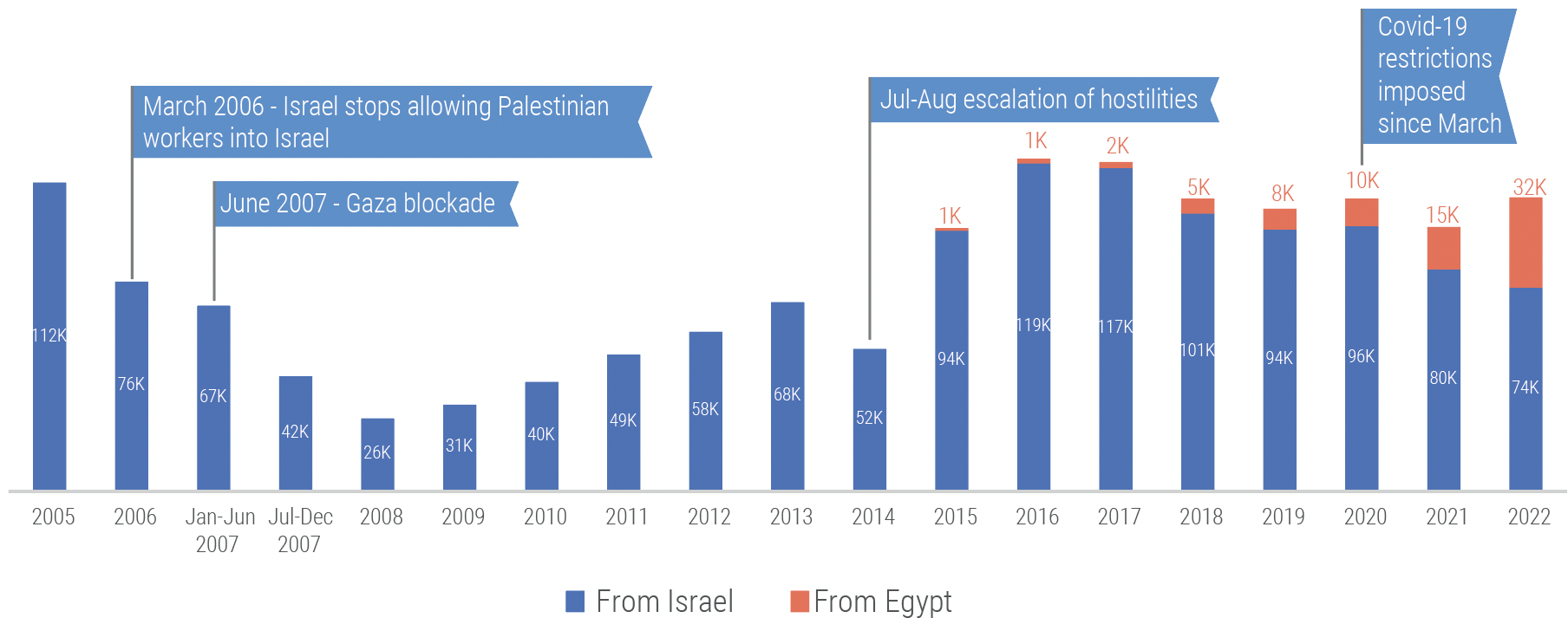
Incoming goods in 2022
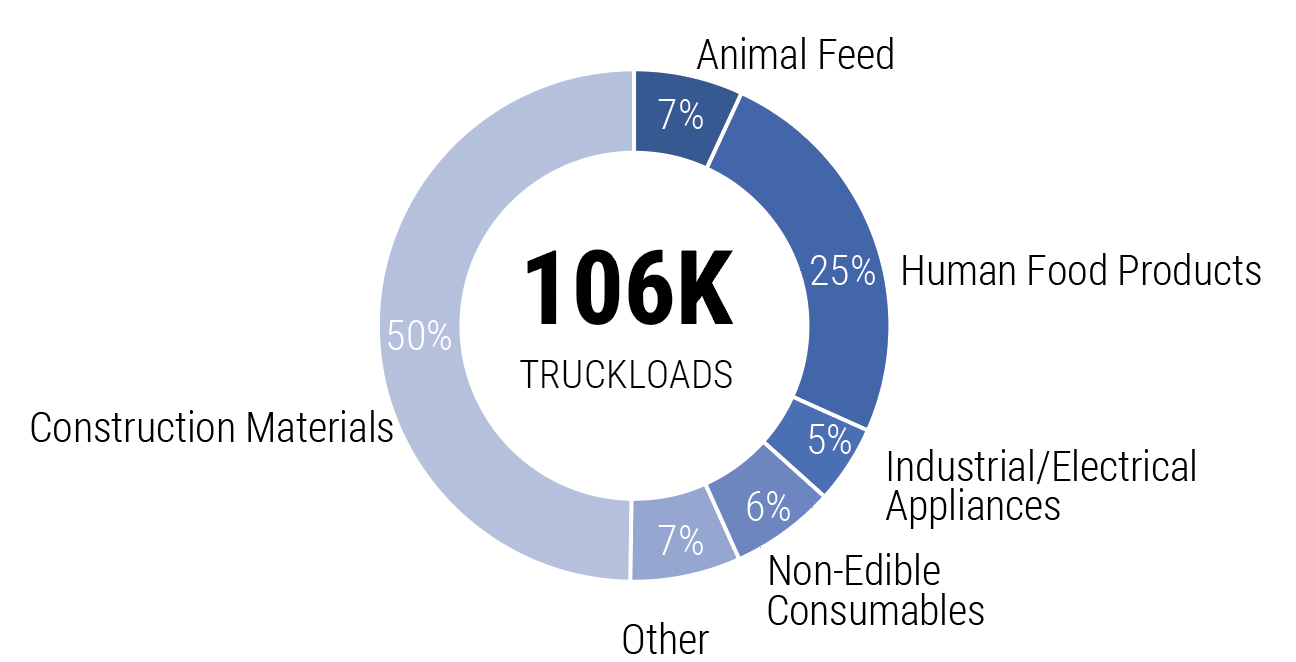
Fuel and gas
- Most of the incoming petrol and diesel, over 91 per cent, was imported from Egypt. The remaining 9 per cent were from Israel, down from 100 per cent in 2016.
- As in previous years, all the industrial diesel, used for the Gaza Power Plant (GPP), entered from Israel. The total volume of about 145.7 million litres was 8 per cent higher compared with the 134.5 million litres recorded in 2021, and 55 per cent higher than the annual average between 2015 and 2021. In 2022, Gaza residents had electricity provided for an average of 12 hours per day, through either the GPP or Israeli feeder lines.
- Import of cooking gas increased, with most of it, almost 63 per cent, coming from Egypt. Until 2017, all the cooking gas would be imported from Israel. The total volume of about 92,000 tons in 2022 was 18 per cent higher than in 2021 and 35 per cent higher than the annual average between 2015 and 2021.
Incoming petrol and diesel (litres)

Incoming industrial diesel from Israel (litres)
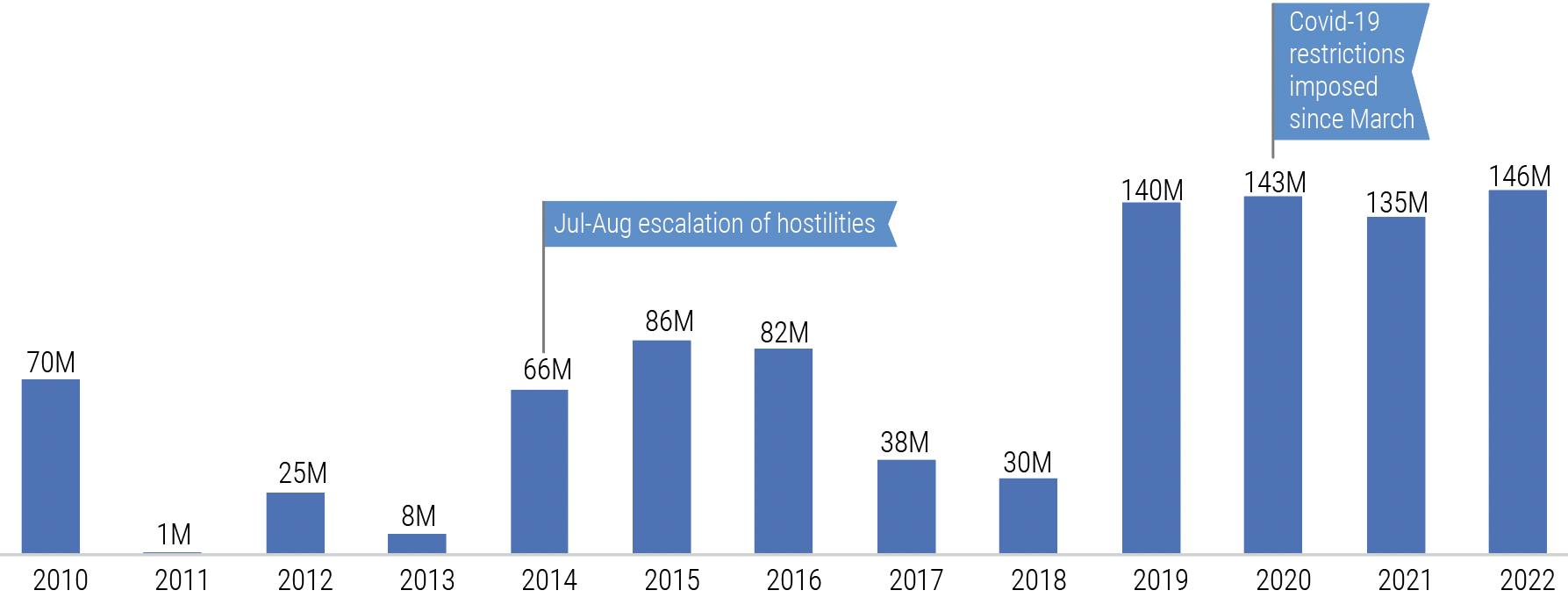
Incoming cooking gas (tons)
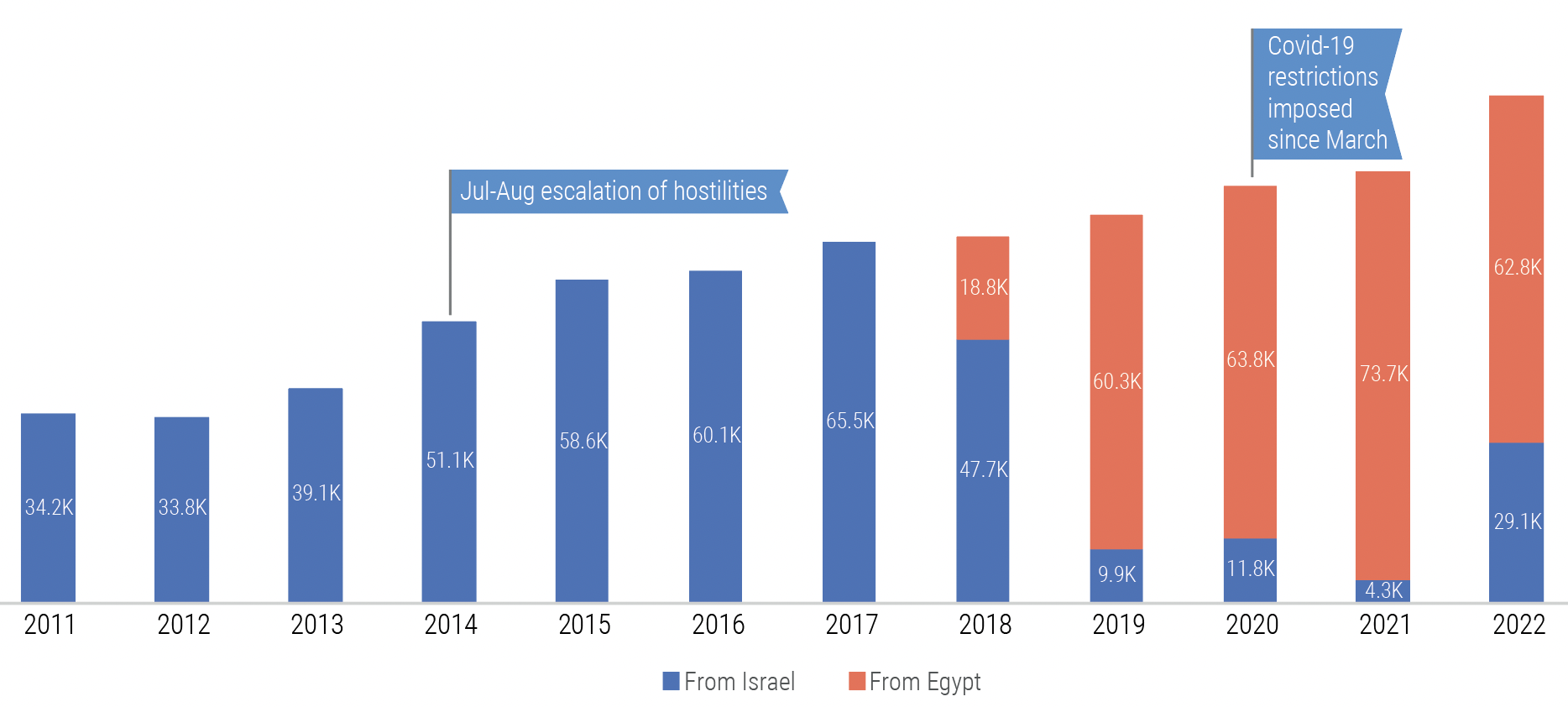
Outgoing goods
- The volume of outgoing goods increased significantly in 2022, reaching levels that are, for the first time, higher than the annual figures recorded on the eve of the 2007 blockade. This is 66 per cent more than in 2021 but 35 per cent less than in 2005, when figures peaked.
- Of the 7,530 truckloads that exited Gaza, 77 per cent went out through the Israeli border, and the remaining 23 per cent went out to Egypt. While transfers to the West Bank (Gaza’s main external market) are only possible through the Israeli border, the Israeli authorities only admit certain types and volume of commodities. The regular export of certain goods to Egypt started in August 2021, and has gradually increased since then.
- The volume of transfers through Israel, 5,834 truckloads, was 43 per cent higher than in 2021. Of that, 71 per cent carried agricultural produce, 13 per cent carried iron scrap, 8 per cent carried clothes and 8 per cent carried other items (including aluminium, copper scrap, furniture, plastic pipes, and leather).
- The volume of export to Egypt, 1,696 truckloads, was three times higher than in 2021. Of these exports, 87.5 per cent were iron scrap, 11.5 per cent were scrap batteries, and 1 per cent carried scrap copper and aluminium.
For more information on the movement in and out of Gaza see:
- Monthly reports: https://ochaopt.org/publications/movement-in-and-out-of-gaza
- Interactive infographics: https://www.ochaopt.org/data/crossings
* Information on the status of border crossings and numbers of truckloads is based on data provided by the Ministry of National Economy in Gaza. Information on the status of Erez crossings and the number of people entering or exiting is based on data provided by the General Authority of Civil Affairs. Information on the status of Rafah crossings and number of people entering or exiting is based on data provided by the General Authority for Crossing in Gaza.
